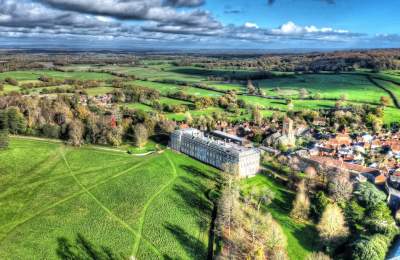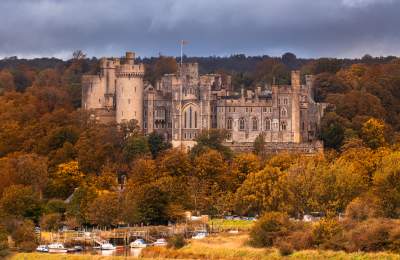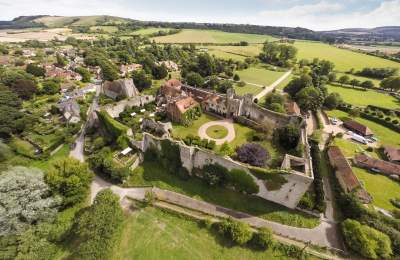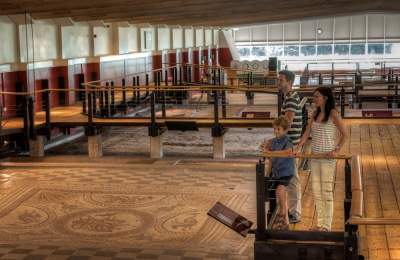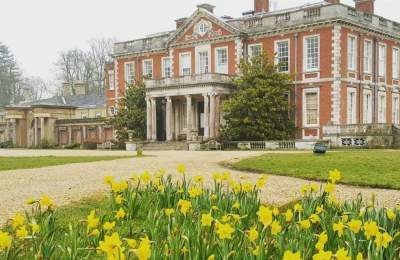There’s no place quite like home… or is there?
With some of the UK’s best countryside on our doorstep, it would only make sense that West Sussex is home to some of the greatest country houses in the UK too.
Find them sprawled across Midhurst, Petworth, Chichester and the South Downs National Park. From manor houses, stately homes, castles and even Roman Villas, West Sussex really does have it all when it comes to great country houses.
Here’s our hand-picked selection of the nine greatest country houses of West Sussex. We’ve also included some recommendations for local lunch stops close to each house, so you can make the most of each visit.
Petworth House
Back to Top of ListWhy Visit: Home to possibly the greatest art collection in the care of the National Trust today, here you’ll find works by the likes of van Dyck, Blake, Reynolds and Titan on display.
About the House: With over 900 years of history, Petworth House came from modest medieval origins before being transformed into a grand mansion in the 17th century, to rival some of the finest palaces in Europe. Belonging to just one family during this time, Petworth House has welcomed many an influential guest - including royalty and celebrated artists - over the years. Step inside to explore grand state rooms and historic Servant Quarters, or venture into the 700-acre deer park and pleasure ground designed by famous landscape architect Lancelot ‘Capability’ Brown.
Don’t miss: The Carved Room, famous for its wood carvings by Grinling Gibbons. From here you’ll also be able to admire some of Turner's Sussex views, painted in Petworth in the early 19th Century.
Looking for a local lunch? We recommend Petworth’s Angel Inn.
Goodwood House
Back to Top of ListWhy Visit: Having been the home of the Dukes of Richmond and Lennox for over 300 years, Goodwood House remains a private home today. With the doors opening for tours on Sundays and Mondays only, you’ll find one of the most significant private art collections in the country inside.
About the House: With connections to royalty, Goodwood House was originally purchased by the 1st Duke of Richmond, the son of King Charles II and his French mistress, Louise de Keroualle. Originally destined to be a hunting lodge, the house has been expanded over the years to create the masterpiece that can be seen today. Rooms include the ballroom, Egyptian dining room, tapestry drawing room and music room. While it’s up for debate whether the design was intentional, the Regency Goodwood House looks like three sides of an octagon, perfectly suited for viewing the magnificent mature parkland that surrounds the house.
Not to be Missed: Follow up your tour of Goodwood House, with an afternoon tea in the picturesque ballroom. Enjoy finger sandwiches, homemade fruit scones and the pastry chef's selection of the day, all made using home-grown and estate-reared produce from Goodwood’s Home Farm.
Looking for a local lunch? If you’re not staying for afternoon tea, we recommend the Goodwood Aerodrome Café.
Uppark House
Back to Top of ListUPPARK IS CLOSED UNTIL LATE SUMMER 2025 FOR A MAINTENANCE PROJECT AND FACILITIES UPGRADE
Why Visit: For picture-perfect panoramic views across the South Downs to the Solent and beyond to the Isle of Wight. Perched high on top of the Downs, you’ll be hard pressed to find a stately home offering such a view.
About the House: Uppark House tells an incredible story of upstairs-downstairs life in the 18th Century. Upstairs, this fine country house is adorned with exquisite French furniture, delicate Dutch porcelains and captivating Italian paintings. Venture downstairs and you’ll find servants quarters and tunnels painting quite a different picture. The writer, HG Wells lived here as a child because he mother was housekeeper for a time.This fascinating house is surrounded by a meadow bursting with wildflowers, a pretty Regency garden and a more modern - but equally as impressive - woodland play area.
Don’t miss: One of the country’s most historically important 18th-century doll's house that is on display. Built in the style of a Palladian mansion, this is one of only a handful from this era that’s survived in such good condition.
Looking for a local lunch? We recommend The White Horse in Chilgrove or La Follia in South Harting.
Parham House
Back to Top of ListWhy Visit: If you’re looking to explore one of the country’s finest Elizabethan houses, then Parham House is the home for you. With little having changed over the centuries, you’ll find things left largely as they were during a time gone by - even the Tudor and Stuart portraits that still decorate the walls. Fresh flower arrangements from in the gardens can be found in every room.
About the House: A family home since its foundation stone was laid during Elizabeth I's reign in 1577, Parham House is still a family home today. Inside, you’ll find the Great Hall, Great Chamber and Long Gallery (the third longest in a private house England), adorned with a fantastic collection of pictures, furniture and needlework. Outside, there’s a picturesque four-acre 18th Century Walled Garden, vegetable garden, glass house and orchard, as well as and a fascinating example of a 1920's Wendy house. In the adjoining Pleasure Grounds, you’ll also find a picnic-perfect lake and a unique brick and turf maze to while away the hours.
Don’t miss: Admire one of the finest and most important collections of early needlework in the country at Parham House. Don’t miss the embroidery on the Great Bed which dates from circa 1585, and its curtains and pelmet from circa 1620.
Looking for a local lunch? We recommend The White Hart near Pulborough.
Arundel Castle
Back to Top of ListWhy Visit: Even though Arundel Castle is home to almost 1,000 years of history, many of its original features remain in place, including the Norman Keep, medieval Gatehouse and Barbican, Baron's Hall, Regency Library and Victorian bedrooms.
About the House: Arundel Castle’s story began in 1607 when it was founded by Roger de Montgomery, a close friend and advisor to William the Conqueror. It was damaged in the English Civil War and then restored in the 18th and 19th centuries by Charles Howard, the 11th Duke of Norfolk. Its story doesn’t end there; step inside to learn about its past, explore the finely preserved interior with its fascinating furniture and tapestries, and admire rare paintings by artists including Van Dyck, Gainsborough and Canaletto.
Don’t miss: Loose yourself in Arundel Castle Gardens, a masterpiece of design. Admire the striking and award-winning Tropical and English Gardens, and keep an eye out for the the castle's quirky Stumpery - a fabulous mix of raw and twisted botanical shapes combined with architectural plants.
Looking for a local lunch? We recommend Arundel’s The Black Rabbit.
Amberley Castle
Back to Top of ListWhy Visit: Recorded in the Doomsday Book as Amberley, Amberley Castle still retains many of its original historic features and decorations. Now a four-star hotel, you’ll have to stay overnight or come for a meal or afternoon tea here to get a glimpse inside. What better excuse for a treat?
About the House: Located in a beautiful setting at the foot of the South Downs, the four-star Amberley Castle is privately owned by Andrew and Christina Brownsword. Enclosed by a 60 foot high curtain wall and portcullis that remains open today, this fascinating 900-year-old-castle was originally a timber framed hunting lodge built by Bishop Luffa. Transformed over 400 years to a fortified manor house, it has today become an enchanting hotel offering you all the luxurious facilities you could dream of on a country break.
Don’t miss: The resident white peacock in the 12 acres of beautifully landscaped gardens outside. While you’re there, explore the green rolling pastures, ancient woodlands and river valleys that have been visited by royalty, politicians and VIPs throughout Amberley’s history.
Looking for a Local Lunch? We recommend The Black Horse in Binsted.
Fishbourne Roman Palace and Gardens
Back to Top of ListWhy visit: For two reasons! Fishbourne Roman Palace (the only Roman palace uncovered in the UK) is home to the largest collection of early Roman mosaic floors in Britain. What’s more, its Roman gardens are also the earliest gardens found anywhere in the country.
About the House: While much of the 'house' is, of course, remains (and remarkable remains at that) it’ll give you a fascinating insight into life during the Roman occupation of Britain. Marvel at over 20 mosaics, learn about the innovative under-floor heating system and admire a huge range of Roman objects found during the excavations. If you're curious to know how Fishbourne Palace may have looked when it was first built, wonder no more. With a short film on show demonstrating how the villa may have looked 2,000 years ago, you’ll be perfectly placed to picture life as a Roman in West Sussex.
Don’t miss: The Roman Garden Museum, where you can learn about the herbs and vegetables of the Roman times, including those used in cooking, medicines and dyeing.
Looking for a local lunch? We recommend The Bosham Inn.
Bignor Roman Villa
Back to Top of ListWhy visit: For world class history set amongst world class views. With the rolling hills of the South Downs as a backdrop, and countryside as far as you can see, you’ll have views to entertain you all day.
About the house: While again, this house is very much remains, you’ll find world-class mosaic floors here, nestled in the heart of the South Downs National Park. Discovered in 1811 by George Tupper, a farmer who struck a mosaic with his plough, the villa has been in the dedicated care of the Tupper family ever since. The remains suggest that the occupants here would have been a wealthy family, and possibly Romano-British. Step inside to see what conclusions you draw for yourself.
Don’t miss: The painting displayed in the foyer of the Villa. It shows how the family who lived here may have dressed. Look out for the man wearing a ring and brooch. Both of these items were found during excavations at the site in the 19th century.
Looking for a local lunch? We recommend The George Eartham.
Stansted House
Back to Top of ListWhy visit: For a real sense of a bygone era at an Edwardian mansion dressed as if the 10th Earl of Bessborough were still at home - and the servants quarters as they would have operated. Surrounded by 1800 acres of parkland and woodlands including a Farm Shop, Garden Centre and the Pavilion Tea Rooms.
About the house: Stansted Park became the residence of the 9th Earl of Bessborough in 1924. The striking Edwardian Mansion stands within 1800 acres of extraordinary landscaped parkland and ancient forest. Visitors can view the house's state rooms from Easter Sunday until the end of September. The rooms are furnished as they would have been by the Bessborough family as they entertained politicians, actors and even royalty. A true contrast of ‘upstairs, downstairs’ is experienced as you the fully furnished Servants Quarters.
Don’t miss: The Grade 1 listed private chapel of St Paul built in the mid 1800s - also open to visitors. Don't miss the stunning East Window said to have inspired poet, John Keats, who used the imagery in his works The Eve of St Agnes and The Eve of St Mark.
Looking for a local lunch? We recommend The Pavilion Tea Rooms
Other Great Country Houses in West Sussex
Inspired by our round up of the greatest country houses of West Sussex?
The eight houses featured above are just the tip of the iceberg. In fact, you could dedicate a whole week to exploring the country houses of West Sussex, and still have more to tick off your list on the next visit. Here are just a few more to inspire you:
Chichester: Explore the charming Grade I Georgian mansion of Edes House in the City Centre. Or venture 10 minutes outside of the City (by car) to the exceptional flint faced manor house of West Dean. Just around the corner from West Dean you’ll find an incredible 50 plus relocated historic houses at the Weald & Downland Living Museum.
Midhurst: In the centre of Midhurst, you’ll find the Cowdray Heritage Ruins, one of England’s most important early Tudor houses which was known to have been visited by both King Henry VIII and Queen Elizabeth I. While you’re there, head to the delightful Woolbeding Gardens, whilst admiring the handsome Georgian Woolbeding House at the same time.
Petworth: Visit Mrs Cummings’ Cottage at Petworth Cottage Museum. The museum is a Leconfield Estate worker's cottage restored and furnished as it may have been circa 1910. The museum also has a rare collection of Petworth Goss China.
Other things to do in West Sussex
There’s plenty more to see and do in West Sussex. Find inspiration for other great things to do here.

